Research Area: Cell Biology

Greta Friar | Whitehead Institute
February 28, 2019
Cambridge, MA — Red blood cells are the most plentiful cell type in our blood and play a vital role transporting oxygen around our body and waste carbon dioxide to the lungs. Injuries that cause significant blood loss prod the body to secrete a one-two punch of signals – stress steroids and erythropoietin (EPO) – that stimulates red blood cell production in the bone marrow. These signals help immature cells along the path to becoming mature red blood cells. In a healthy individual, as much as half of their blood volume can be replenished within a week. Despite its importance, scientists are still working to unravel many aspects of red blood cell production. In a paper published online February 28 in the journal Developmental Cell, Whitehead Institute researchers describe work that refines our understanding of how stress steroids, in particular glucocorticoids, increase red blood cell production and how early red blood cell progenitors progress to the next stage of maturation toward mature red blood cells.
These findings are especially important for patients with certain types of anemia that do not respond to clinical use of EPO to stimulate the final stages of red cell formation, such as Diamond-Blackfan anemia (DBA). In this rare genetic disorder usually diagnosed in infants and toddlers, the bone marrow does not produce enough of early red blood cell progenitors, called burst forming unit-erythroids (BFU-Es), that respond to glucocorticoids. In both healthy people and DBA patients, these BFU-Es divide several times and mature before developing into colony forming unit-erythroids (CFU-Es) that that, stimulated by EPO, repeatedly divide and produce immature red blood cells that are released from the bone marrow into the blood. But the lack of BFU-Es in DBA patients means that the glucocorticoid signal has a limited target, and the cascade of cell divisions that should result in plentiful red blood cells is contracted and instead produces an insufficient amount.
One of the standard treatments for DBA is boosting red blood cell production with high doses of synthetic glucocorticoids, such as prednisone or prednisolone. But the mechanisms behind these drugs and their normal counterparts are not well understood. By deciphering the mechanisms by which glucocorticoids stimulate red cell formation, scientists may be able identify other ways to stoke CFU-E production – and ultimately red blood cell production – without synthetic glucocorticoids and the harsh side effects that their long-term use can cause, such as poor growth in children, brittle bones, muscle weakness, diabetes, and eye problems.
For more than two decades, Whitehead Institute Founding Member Harvey Lodish, has investigated glucocorticoids’ effects on red blood cell production. In his lab’s most recent paper, co-first authors and postdocs Hojun Li and Anirudh Natarajan, describe their research, which helps decipher how BFU-Es progress through their maturation process.
For more than 30 years, scientists have thought that glucocorticoids bestowed BFU-Es with a stem cell-like ability to divide until an unknown switch flipped and the cells matured to the CFU-E stage. By looking at gene expression in individual BFU-Es from normal mice, Li and Natarajan determined that the developmental progression from BFU-E to CFU-E is instead a smooth continuum. They also found that in mice glucocorticoids exert the greatest effect on the BFU-Es at the beginning of the developmental continuum by slowing their developmental progression without affecting their cell division rate. In other words glucocorticoids are able to effectively compensate for a decreased number of BFU-Es by allowing those that do exist, while still immature, to divide more times, producing in mice up to 14 times more CFU-Es than BFU-Es lacking exposure to glucocorticoids.
Li and Natarajan’s work reveals previously unknown aspects of the mechanism by which glucocorticoids stimulate red blood cell production. With this better understanding, scientists are one step closer toward pinpointing more targeted approaches to treat certain anemias such as DBA.
This work was supported by the National Institutes of Health (NIH grants DK06834813 and HL032262-25) and the American Society of Hematology and was performed with the assistance of Whitehead Institute’s Fluorescence Activated Cell Scanning (FACS) Facility and Genome Technology Core facility. Styliani Markoulaki, head of the Whitehead Genetically Engineered Models Center, and M. Inmaculada Barrasa of Bioinformatics and Research Computing (BaRC) are also co-authors of the paper.
Written by Nicole Giese Rura
***
Harvey Lodish’s primary affiliation is with Whitehead Institute for Biomedical Research, where his laboratory is located and all his research is conducted. He is also a professor of biology and a professor of biological engineering at Massachusetts Institute of Technology (MIT). Lodish serves as a paid consultant and owns equity in Rubius, a biotech company that seeks to exploit the use of modified red blood cells for therapeutic applications.
***
Citation:
“Rate of Progression through a Continuum of Transit-Amplifying Progenitor Cell States Regulates Blood Cell Production”
Developmental Cell, online February 28, 2019, https://doi.org/10.1016/j.devcel.2019.01.026
Hojun Li*, Anirudh Natarajan*, Jideofor Ezike, M. Inmaculada Barrasa, Yenthanh Le, Zoë A. Feder, Huan Yang, Clement Ma, Styliani Markoulaki, and Harvey F. Lodish.
*These authors contributed equally
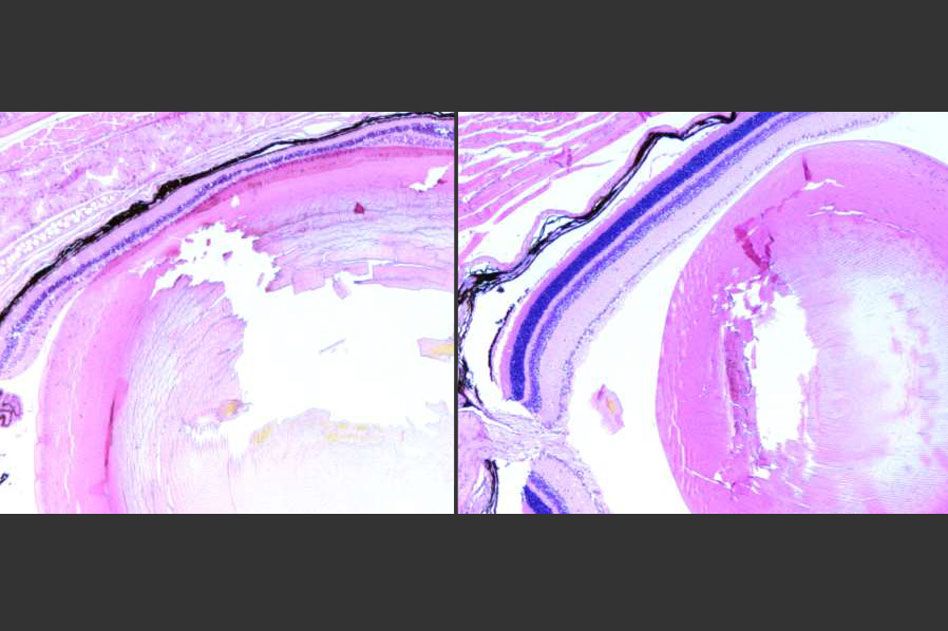
Overactive repair system promotes cell death following DNA damage by certain toxins, study shows.
Anne Trafton | MIT News Office
February 14, 2019
DNA-repair enzymes help cells survive damage to their genomes, which arises as a normal byproduct of cell activity and can also be caused by environmental toxins. However, in certain situations, DNA repair can become harmful to cells, provoking an inflammatory response that produces severe tissue damage.
MIT Professor Leona Samson has now determined that inflammation is a key component of the way this damage occurs in photoreceptor cells in the retinas of mice. About 10 years ago, she and her colleagues discovered that overactive initiation of DNA-repair systems can lead to retinal damage and blindness in mice. The key enzyme in this process, known as Aag glycosylase, can also cause harm in other tissues when it becomes hyperactive.
“It’s another case where despite the fact that inflammation is there to protect you, in some circumstances it can actually be harmful, when it’s overactive,” says Samson, a professor emerita of biology and biological engineering and the senior author of the study.
Aag glycosylase helps to repair DNA damage caused by a class of drugs known as alkylating agents, which are commonly used as chemotherapy drugs and are also found in pollutants such as tobacco smoke and fuel exhaust. Retinal damage from these drugs has not been seen in human patients, but alkylating agents may produce similar damage in other human tissues, Samson says. The new study, which reveals how Aag overactivity leads to cell death, suggest possible targets for drugs that could prevent such damage.
Mariacarmela Allocca, a former MIT postdoc, is the lead author of the study, which appears in the Feb. 12 issue of Science Signaling. MIT technical assistant Joshua Corrigan, former postdoc Aprotim Mazumder, and former technical assistant Kimberly Fake are also authors of the paper.
A vicious cycle
In a 2009 study, Samson and her colleagues found that a relatively low level of exposure to an alkylating agent led to very high rates of retinal damage in mice. Alkylating agents produce specific types of DNA damage, and Aag glycosylase normally initiates repair of such damage. However, in certain types of cells that have higher levels of Aag, such as mouse photoreceptors, the enzyme’s overactivity sets off a chain of events that eventually leads to cell death.
In the new study, the researchers wanted to find exactly out how this happens. They knew that Aag was overactive in the affected cells, but they didn’t know exactly how it was leading to cell death or what type of cell death was occurring. The researchers initially suspected it was apoptosis, a type of programmed cell death in which a dying cell is gradually broken down and absorbed by other cells.
However, they soon found evidence that another type of cell death called necrosis accounts for most of the damage. When Aag begins trying to repair the DNA damage caused by the alkylating agent, it cuts out so many damaged DNA bases that it hyperactivates an enzyme called PARP, which induces necrosis. During this type of cell death, cells break apart and spill out their contents, which alerts the immune system that something is wrong.
One of the proteins secreted by the dying cells, known as HMGB1, stimulates production of chemicals that attract immune cells called macrophages, which specifically penetrate the photoreceptor layer of the retina. These macrophages produce highly reactive oxygen species — molecules that create more damage and make the environment even more inflammatory. This in turn causes more DNA damage, which is recognized by Aag.
“That makes the situation worse, because the Aag glycosylase will act on the lesions produced from the inflammation, so you get a vicious cycle, and the DNA repair drives more and more degeneration and necrosis in the photoreceptor layer,” Samson says.
None of this happens in mice that lack Aag or PARP, and it does not occur in other cells of the eye or in most other body tissues.
“It amazes me how segmented this is. The other cells in the retina are not affected at all, and they must experience the same amount of DNA damage. So, one possibility is maybe they don’t express Aag, while the photoreceptor cells do,” Samson says.
“These molecular studies are exciting, as they have helped define the underlying pathophysiology associated with retinal damage,” says Ben Van Houten, a professor of pharmacology and chemical biology at the University of Pittsburgh, who was not involved in the study. “DNA repair is essential for the faithful inheritance of a cell’s genetic material. However, the very action of some DNA repair enzymes can result in the production of toxic intermediates that exacerbate exposures to genotoxic agents.”
Varying effects
The researchers also found that retinal inflammation and necrosis were more severe in male mice than in female mice. They suspect that estrogen, which can interfere with PARP activity, may help to suppress the pathway that leads to inflammation and cell death.
Samson’s lab has previously found that Aag activity can also exacerbate damage to the brain during a stroke, in mice. The same study revealed that Aag activity also worsens inflammation and tissue damage in the liver and kidney following oxygen deprivation. Aag-driven cell death has also been seen in the mouse cerebellum and some pancreatic and bone marrow cells.
The effects of Aag overactivity have been little studied in humans, but there is evidence that healthy individuals have widely varying levels of the enzyme, suggesting that it could have different effects in different people.
“Presumably there are some cell types in the human body that would respond the same way as the mouse photoreceptors,” Samson says. “They may just not be the same set of cells.”
The research was funded by the National Institutes of Health.
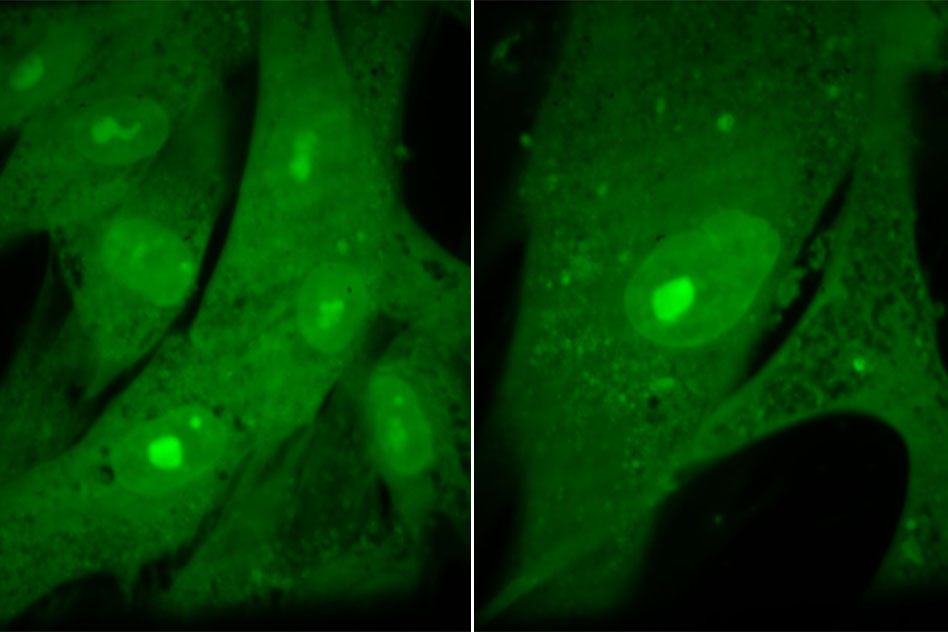
The need to produce just the right amount of protein is behind the striking uniformity of sizes.
Anne Trafton | MIT News Office
February 7, 2019
MIT biologists have discovered the answer to a fundamental biological question: Why are cells of a given type all the same size?
In humans, cell size can vary more than 100-fold, ranging from tiny red blood cells to large neurons. However, within each cell type, there is very little deviation from a standard size. In studies of yeast, MIT researchers grew cells to 10 times their normal size and found that their DNA could not keep up with the demands of producing enough protein to maintain normal cell functions.
Furthermore, the researchers found that this protein shortage leads the cells into a nondividing state known as senescence, suggesting a possible explanation for how cells become senescent as they age.
“There are so many hypotheses out there that try to explain why senescence happens, and I think this data provides a beautiful and simple explanation for senescence,” says Angelika Amon, the Kathleen and Curtis Marble Professor in Cancer Research in the Department of Biology and a member of the Koch Institute for Integrative Cancer Research.
Amon is the senior author of the study, which appears in the Feb. 7 online edition of Cell. Gabriel Neurohr, an MIT postdoc, is the lead author of the paper.
Excessive size
To explore why cell size is so tightly controlled, the researchers prevented yeast cells from dividing by modifying a gene critical for cell division, so that it could be turned off at a certain temperature. These cells continued to grow, but they could not divide and they did not replicate their DNA.
The researchers discovered that as the cells expanded, their DNA and their protein-building machinery could not keep pace with the needs of such a large cell. This failure to produce enough protein led to the dilution of the cytoplasm and disruption of cell division. The researchers believe that many other fundamental cell processes that rely on cellular molecules finding and interacting with each other may also be impaired when cells are too big.
“Theoretical models predict that diluting the cytoplasm will decrease reaction rates. Every chemical reaction would occur more slowly, and some threshold concentrations of certain proteins may not be reached, so certain reactions would never happen because the concentrations are lower,” Neurohr says.
The researchers showed that yeast cells with two sets of chromosomes were able to grow to twice the size of yeast cells with just one set of chromosomes before becoming senescent, suggesting that the amount of DNA in the cells is the limiting factor in the cells’ ability to grow.
Experiments with human cells yielded similar results: In a study of human fibroblast cells, the researchers found that forcing the cells to grow to excessive sizes (eight times their normal size) disrupted many functions, including cell division.
“It’s been clear for some time that cells do control their size, but it’s been unclear what the various physiological reasons are for why they do so,” says Jan Skotheim, an associate professor of biology at Stanford University, who was not involved in the research. “What’s nice about this work is it really shows how things go wrong when cells get too big.”
Age-related disease
Amon says excessive growth likely plays a major role in the development of senescence, which occurs in many types of mammalian cells and is thought to contribute to age-related organ dysfunction and chronic age-related diseases.
Senescent cells are often larger than younger cells, and this study, which showed that unchecked cell growth leads to senescence, offers a possible explanation for this observation. Human cells tend to grow slightly larger throughout their lifetimes, because every time a cell divides, it checks for DNA damage, and if any is found, division is halted while repairs are made. During each of these delays, the cell grows slightly larger.
“Over the lifetime of a cell, the more divisions you make, the higher your probability is of having that damage, and over time cells will get larger,” Amon says. “Eventually they get so large that they start diluting critical factors that are important for proliferation.”
A difficult question that remains unanswered is how different types of cells maintain the appropriate size for their cell type, which the researchers now hope to study further.
The research was funded, in part, by the National Institutes of Health, the Howard Hughes Medical Institute, the Paul F. Glenn Center for Biology of Aging Research at MIT, a National Science Foundation graduate research fellowship, the William Bowes Fellows program, and the Vilcek Foundation.
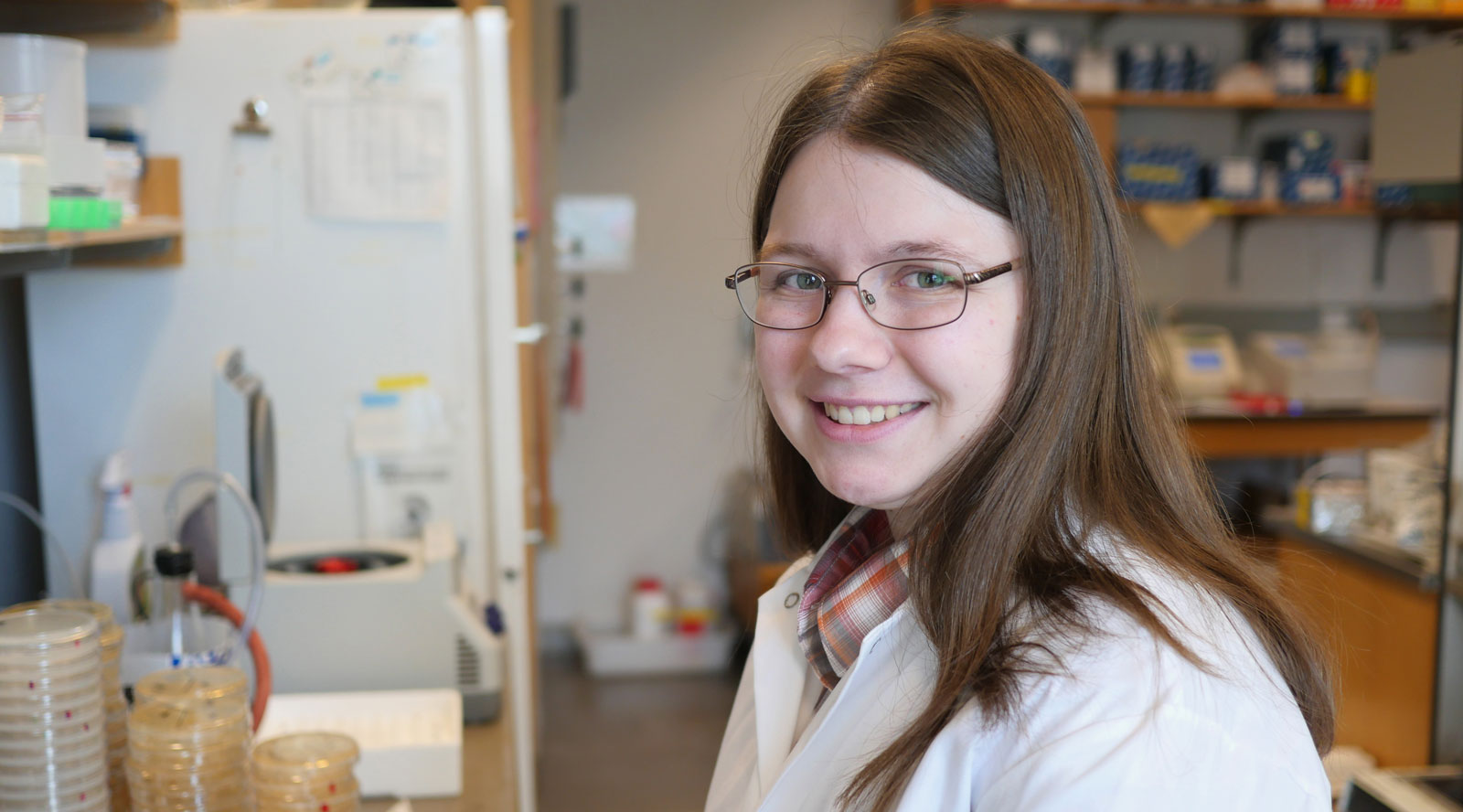
Junior Leah McKinney practiced kitchen microbiology on her ranch in Nevada before exploring the intricacies of DNA replication initiation in bacteria at MIT Biology.
Raleigh McElvery
February 6, 2019
Leah McKinney grew up on a 50,000-acre cattle ranch in Nevada — vaccinating sheep, roping calves, digging for fossils, and occasionally hauling home old bovine femurs. She saddled horses, treated sick lambs, and helped ewes struggling to give birth. One Christmas, she even asked Santa for a fetal pig. “He delivered,” McKinney, now a junior in Course 7, recalls with a laugh.
When she was 12 years old, she saved up enough birthday money to purchase a microscope. Even though she permanently dyed the kitchen sink a distinct shade of blue while making slides, her parents (who both hold degrees in animal science) didn’t mind. They even let her grow bacteria in the heater closet and tally them on the kitchen counter — all in the name of the elementary school science fair.
“They were always encouraging my weird scientific endeavors,” she says. “I think my love for science, and microbiology specifically, came out of my agricultural upbringing.”
She grew to appreciate basic science because it allowed her to study the fundamental mechanisms behind key biological processes. She arrived at MIT in 2016 determined to major in Biology, and hasn’t wavered in her decision. Although she relishes the subject matter, she initially feared the classes would be tedious and memorization-heavy.
“I was quite happy to learn that’s not the case here,” she says. “MIT Biology values problem-solving over rote memorization, and encourages you to take the information you’ve learned in class and apply it to interesting problems. And that mindset extends from the classroom into the lab.”
One of the things that drew McKinney to MIT was the institute’s Undergraduate Research Opportunities Program (UROP), which allows students to join labs and collaborate with faculty as early as their first year. She recalls that, while other universities touted similar opportunities, MIT placed theirs front and center.
“I’d heard that all you had to do was email a professor and ask to join the lab, but I didn’t believe it — that just seemed way too easy,” McKinney says. “But when I was looking for a UROP, I just emailed my current principal investigator to set up a time to talk, and now I’ve been in his lab for over a year.”
McKinney is part of Department Head Alan Grossman’s lab, which investigates the molecular mechanisms and regulation underlying basic cellular processes in bacteria. The entire group works with the rod-shaped Bacillus subtilis, but some members study horizontal gene transfer while others focus on DNA replication and gene expression. McKinney and her graduate student mentor Mary Anderson are in this second category, examining a protein called DnaA that is required to initiate DNA replication and also modulates the expression of several genes.
In order to successfully grow and reproduce, a bacterium must first replicate its single chromosome before dividing into two identical daughter cells. DnaA is responsible for beginning DNA replication in all bacteria. It binds to the origin of replication on the chromosome, unwinds some of the nearby DNA, and recruits the other proteins needed to copy the chromosome.
This operation is highly regulated to ensure that each daughter cell receives only a single chromosome. B. subtilis controls replication via several proteins, including YabA. When YabA binds to DnaA, it prevents replication from ever getting started.
Since DnaA also serves as a transcription factor — binding to other DNA sequences called promoters to increase or decrease expression of certain genes, including its own gene dnaA — YabA may also impact DnaA’s gene targets. McKinney hopes to eventually determine exactly how.
While McKinney discovers something new about her bacteria each time she conducts a successful experiment, she learns almost as much when her tests go awry. “I’ve had to practice a lot of troubleshooting,” she says, “and that’s not something you can learn in class. But everyone in the lab is incredibly friendly and always willing to answer questions or give advice.”
As a teaching assistant for the lab class 7.02 (Introduction to Experimental Biology and Communication), McKinney had the chance to help other students conduct experiments, answering their questions and grading their lab notebooks. She took 7.02 last spring, but says it’s been enlightening to experience the class through a different lens. She adds: “I definitely understand the material more deeply than I did before.”
In addition to TAing, McKinney teaches an SAT preparatory program run by MIT students. “At first, standing up and talking in front of a 20-person section was rather terrifying, but it’s become so much easier,” she says. “The experience has been really good for me.”
After she graduates, McKinney knows she wants to go to graduate school — likely for microbiology — but beyond that, nothing is concrete. She is sure of one thing, though: joining the Grossman lab was one of the best decisions she’s made at MIT.
She advises all current and prospective students to do a UROP. “Find something you’re really interested in,” she says. “It’s okay not to know a lot coming in; you’re going to learn so much, including topics and techniques you won’t learn in class. And don’t be too disappointed when things don’t work; that’s just part of the process. And when you finally get something to work that you’ve been troubleshooting for a while, the feeling is absolutely amazing.”
Posted 2.5.19
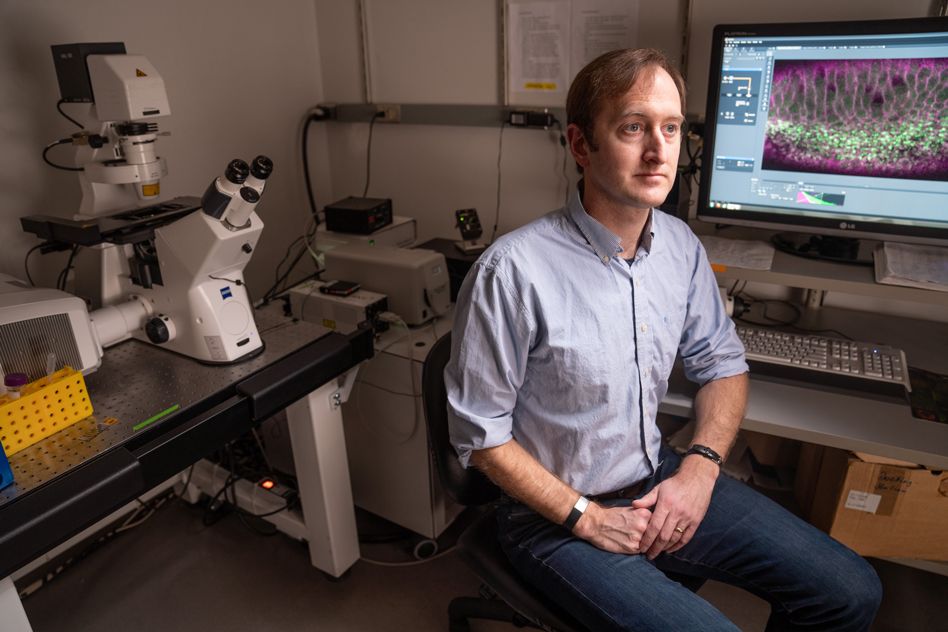
The dynamic process is critical to embryonic development and other cellular phenomena.
Anne Trafton | MIT News Office
February 1, 2019
Embryonic development is tightly regulated by genes that control how body parts form. One of the key responsibilities of these genes is to make sure that tissues fold into the correct shapes, forming structures that will become the spine, brain, and other body parts.
During the 1970s and ’80s, the field of embryonic development focused mainly on identifying the genes that control this process. More recently, many biologists have shifted toward investigating the physics behind the tissue movements that occur during development, and how those movements affect the shape of tissues, says Adam Martin, an MIT associate professor of biology.
Martin, who recently earned tenure, has made key discoveries in how tissue folding is controlled by the movement of cells’ internal scaffolding, known as the cytoskeleton. Such discoveries can not only shed light on how tissues form, including how birth defects such as spina bifida occur, but may also help guide scientists who are working on engineering artificial human tissues.
“We’d like to understand the molecular mechanisms that tune how forces are generated by cells in a tissue, such that the tissue then gets into a proper shape,” Martin says. “It’s important that we understand fundamental mechanisms that are in play when tissues are getting sculpted in development, so that we can then harness that knowledge to engineer tissues outside of the body.”
Cellular forces
Martin grew up in Rochester, New York, where both of his parents were teachers. As a biology major at nearby Cornell University, he became interested in genetics and development. He went on to graduate school at the University of California at Berkeley, thinking he would study the genes that control embryonic development.
However, while in his PhD program, Martin became interested in a different phenomenon — the role of the cytoskeleton in a process called endocytosis. Cells use endocytosis to absorb many different kinds of molecules, such as hormones or growth factors.
“I was interested in what generates the force to promote this internalization,” Martin says.
He discovered that the force is generated by the assembly of arrays of actin filaments. These filaments tug on a section of the cell membrane, pulling it inward so that the membrane encloses the molecule being absorbed. He also found that myosin, a protein that can act as a motor and controls muscle contractions, helps to control the assembly of actin filaments.
After finishing his PhD, Martin hoped to find a way to combine his study of cytoskeleton mechanics with his interest in developmental biology. As a postdoc at Princeton University, he started to study the phenomenon of tissue folding in fruit fly embryonic development, which is now one of the main research areas of his lab at MIT. Tissue folding is a ubiquitous shape change in tissues to convert a planar sheet of cells into a three-dimensional structure, such as a tube.
In developing fruit fly embryos, tissue folding invaginates cells that will form internal structures in the fly. This folding process is similar to tissue folding events in vertebrates, such as neural tube formation. The neural tube, which is the precursor to the vertebrate spinal cord and brain, begins as a sheet of cells that must fold over and “zip” itself up along a seam to form a tube. Problems with this process can lead to spina bifida, a birth defect that results from an incomplete closing of the backbone.
When Martin began working in this area, scientists had already discovered many of the transcription factors (proteins that turn on networks of specific genes) that control the folding of the neural tube. However, little was known about the mechanics of this folding.
“We didn’t know what types of forces those transcription factors generate, or what the mechanisms were that generated the force,” he says.
He discovered that the accumulation of myosin helps cells lined up in a row to become bottle-shaped, causing the top layer of the tissue to pucker inward and create a fold in the tissue. More recently, he found that myosin is turned on and off in these cells in a dynamic way, by a protein called RhoA.
“What we found is there’s essentially an oscillator running in the cells, and you get a cycle of this signaling protein, RhoA, that’s being switched on and off in a cyclical manner,” Martin says. “When you don’t have the dynamics, the tissue still tries to contract, but it falls apart.”
He also found that the dynamics of this myosin activity can be disrupted by depleting genes that have been linked to spina bifida.
Breaking free
Another important cellular process that relies on tissue folding is the epithelial-mesenchymal transition (EMT). This occurs during embryonic development when cells gain the ability to break free and move to a new location. It is also believed to occur when cancer cells metastasize from tumors to seed new tumors in other parts of the body.
During embryonic development, cells lined up in a row need to orient themselves so that when they divide, both daughter cells remain in the row. Martin has shown that when the mechanism that enables the cells to align correctly is disrupted, one of the daughter cells will be squeezed out of the tissue.
“This has been proposed as one way you can get an epithelial-to-mesenchymal transition, where you have cells dissociate from native tissue,” Martin says. He now plans to further study what happens to the cells that get squeezed out during the EMT.
In addition to these projects, he is also collaborating with Jörn Dunkel, an MIT associate professor of mathematics, to map the network connections between the myosin proteins that control tissue folding during development. “That project really highlights the benefits of getting people from diverse backgrounds to analyze a problem,” Martin says.
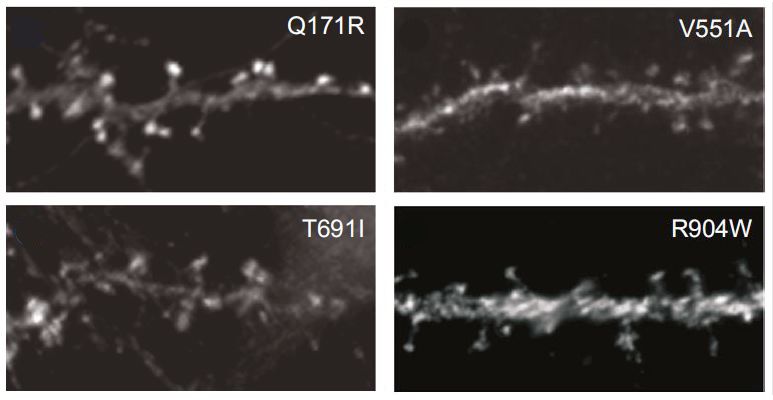
Findings could help inform new therapies, improve diagnosis.
David Orenstein | Picower Institute for Learning and Memory
January 18, 2019
A new study by researchers at the Picower Institute for Learning and Memory at MIT finds that the protein CPG2 is significantly less abundant in the brains of people with bipolar disorder (BD) and shows how specific mutations in the SYNE1 gene that encodes the protein undermine its expression and its function in neurons.
Led by Elly Nedivi, professor in MIT’s departments of Biology and Brain and Cognitive Sciences, and former postdoc Mette Rathje, the study goes beyond merely reporting associations between genetic variations and psychiatric disease. Instead, the team’s analysis and experiments show how a set of genetic differences in patients with bipolar disorder can lead to specific physiological dysfunction for neural circuit connections, or synapses, in the brain.
The mechanistic detail and specificity of the findings provide new and potentially important information for developing novel treatment strategies and for improving diagnostics, Nedivi says.
“It’s a rare situation where people have been able to link mutations genetically associated with increased risk of a mental health disorder to the underlying cellular dysfunction,” says Nedivi, senior author of the study online in Molecular Psychiatry. “For bipolar disorder this might be the one and only.”
The researchers are not suggesting that the CPG2-related variations in SYNE1 are “the cause” of bipolar disorder, but rather that they likely contribute significantly to susceptibility to the disease. Notably, they found that sometimes combinations of the variants, rather than single genetic differences, were required for significant dysfunction to become apparent in laboratory models.
“Our data fit a genetic architecture of BD, likely involving clusters of both regulatory and protein-coding variants, whose combined contribution to phenotype is an important piece of a puzzle containing other risk and protective factors influencing BD susceptibility,” the authors wrote.
CPG2 in the bipolar brain
During years of fundamental studies of synapses, Nedivi discovered CPG2, a protein expressed in response to neural activity, that helps regulate the number of receptors for the neurotransmitter glutamate at excitatory synapses. Regulation of glutamate receptor numbers is a key mechanism for modulating the strength of connections in brain circuits. When genetic studies identified SYNE1 as a risk gene specific to bipolar disorder, Nedivi’s team recognized the opportunity to shed light into the cellular mechanisms of this devastating neuropsychiatric disorder typified by recurring episodes of mania and depression.
For the new study, Rathje led the charge to investigate how CPG2 may be different in people with the disease. To do that, she collected samples of postmortem brain tissue from six brain banks. The samples included tissue from people who had been diagnosed with bipolar disorder, people who had neuropsychiatric disorders with comorbid symptoms such as depression or schizophrenia, and people who did not have any of those illnesses. Only in samples from people with bipolar disorder was CPG2 significantly lower. Other key synaptic proteins were not uniquely lower in bipolar patients.
“Our findings show a specific correlation between low CPG2 levels and incidence of BD that is not shared with schizophrenia or major depression patients,” the authors wrote.
From there they used deep-sequencing techniques on the same brain samples to look for genetic variations in the SYNE1 regions of BD patients with reduced CPG2 levels. They specifically looked at ones located in regions of the gene that could regulate expression of CPG2 and therefore its abundance.
Meanwhile, they also combed through genomic databases to identify genetic variants in regions of the gene that code CPG2. Those mutations could adversely affect how the protein is built and functions.
Examining effects
The researchers then conducted a series of experiments to test the physiological consequences of both the regulatory and protein coding variants found in BD patients.
To test effects of non-coding variants on CPG2 expression, they cloned the CPG2 promoter regions from the human SYNE1 gene and attached them to a “reporter” that would measure how effective they were in directing protein expression in cultured neurons. They then compared these to the same regions cloned from BD patients that contained specific variants individually or in combination. Some did not affect the neurons’ ability to express CPG2 but some did profoundly. In two cases, pairs of variants (but neither of them individually), also reduced CPG2 expression.
Previously Nedivi’s lab showed that human CPG2 can be used to replace rat CPG2 in culture neurons, and that it works the same way to regulate glutamate receptor levels. Using this assay they tested which of the coding variants might cause problems with CPG2’s cellular function. They found specific culprits that either reduced the ability of CPG2 to locate in the “spines” that house excitatory synapses or that decreased the proper cycling of glutamate receptors within synapses.
The findings show how genetic variations associated with BD disrupt the levels and function of a protein crucial to synaptic activity and therefore the health of neural connections. It remains to be shown how these cellular deficits manifest as biopolar disorder.
Nedivi’s lab plans further studies including assessing behavioral implications of difference-making variants in lab animals. Another is to take a deeper look at how variants affect glutamate receptor cycling and whether there are ways to fix it. Finally, she said, she wants to continue investigating human samples to gain a more comprehensive view of how specific combinations of CPG2-affecting variants relate to disease risk and manifestation.
In addition to Rathje and Nedivi, the paper’s other authors are Hannah Waxman, Marc Benoit, Prasad Tammineni, Costin Leu, and Sven Loebrich.
The JPB Foundation, the Gail Steel Fund, the Carlsberg Foundation, the Lundbeck Foundation and the Danish Council for Independent Research funded the study.
January 2, 2019

Senior Anna Sappington found her perfect balance of “innovative computer science and innovative biology” as a member of the team mapping every cell in the human body.
Raleigh McElvery
December 5, 2018
When Anna Sappington was six years old, her parents gave her a black and white composition notebook. Together, they began jotting down observations to identify the patterns in their wooded backyard near the Chesapeake Bay. How would the harsh winters or the early springs affect the blooming trees? How many bluebirds nested each season and how many eggs would they lay? When would the cicada population cycle peak? Her father, the environmental scientist, taught her to sift through data to uncover the trends. Her mother, the journalist, gave her the words to describe her findings.
But it wasn’t until Sappington competed in the Intel International Science and Engineering Fair her junior year of high school that she probed one tiny niche of the natural world more keenly than she ever had before: the physiology of the water flea. Specifically, she investigated the developmental changes that these minute creatures experienced after being exposed to the antimicrobial compound triclosan, present in many soaps and toothpastes. She was surprised to learn that it required only a low concentration of triclosan (0.5 ppm) to cause developmental defects.
She’d been familiar with the concept of DNA since middle school, but her fellow science fair finalists were delving beyond their observations and into the letters of the genetic code. This gave her a new impetus: to understand how triclosan worked at the level of the genome and epigenome to engender the physical deformities she observed under the microscope. She just needed the proper tools, so she made some calls.
Environmental geneticist and water flea aficionado John Colbourne took an interest, and invited her to his lab at University of Birmingham in the U.K. the following summer so she could learn basic lab techniques. Although her friends and classmates didn’t quite get why she needed to travel to an entirely different country to study an organism they’d never heard of, as she puts it, she had burning scientific questions that needed answers.
“That was the experience that really turned me on to genomics,” says Sappington, now a senior and 6-7 (Computer Science and Molecular Biology) major. “I was finally getting the tools to dig through large amounts of data, using code to find patterns and meaning. I wanted to keep asking ‘why?’ and ‘how?’ all the way down to the molecular level.”
The summer before her freshman year of college, Sappington asked these questions in humans for the time as an intern at the National Human Genome Research Institute (NHGRI). There, she helped create a computational pipeline to identify the genomic changes associated with heightened risk of cardiovascular disease.
She enrolled at MIT the following fall, because she wanted to be around people from every scientific subfield imaginable. When she arrived, the joint major in computer science and biology was still relatively new.
“While a few of the required classes did meld the two, many of them offered training in each separately,” she says. “That approach really appealed to me because I was hoping to develop both skill sets independently. I wanted to learn code and write algorithms that could be applied to any field, and I also loved understanding the biological mechanisms behind different diseases and viruses.”
Before she’d even officially declared her major, Sappington was already running experiments in Sangeeta Bhatia’s lab. There, at the Koch Institute, she studied the effects of HPV infection on gene expression in liver cells. Sappington’s main role was data analysis, striving to determine which genes were amplified in response to disease.Despite their obvious differences, Sappington found the two areas to be more similar than she had initially anticipated. In her Introduction to Algorithms class, she leveraged an arsenal of algorithms with certain outputs, conditions, and run times to decode her problem sets. In Organic Chemistry, she deployed a list of foundational reactions to solve synthesis questions on her exams. “In each case, you have to combine your understanding of these fundamental rules and come up with a creative solution to decipher an unknown,” she says.
One year later, Sappington moved to Aviv Regev’s lab at the Broad Institute. There, she learned computational techniques for decoding protein interaction networks. After a year, she began working on an international project called the Human Cell Atlas as a member of the Regev and the Sanes lab collaboration.
“The overarching mission is to create a reference map of all human cells,” Sappington explains. “We want to add a layer of functional understanding on top of what we know about the genome, to understand how different cell types differ and how they interact to impact disease. This kind of endeavor has never been undertaken on such a large scale before, so it’s incredibly exciting.”
Even within a single cell type — say, retinal cells — there are about six main cell categories, each of which splinter into as many as 40 subtypes with distinct molecular profiles and roles.
Beyond the biological challenges that go along with trying to distinguish all these cell types, there are numerous computational hurdles as well. Sappington enjoys these the most — grappling with how best to analyze the gene expression of a single cell separated from its tissue of origin.
“Since you’re only working with single cells rather than entire groups of cells from a tissue, the data that you get are much more sparse,” she says. “You have to sequence a lot of individual cells and build up lots of statistical power before you can be confident that a given cell is expressing specific genes. Coming up with models to determine what constitutes a cell type — and map cell types between time points or between species — are broad problems in computer science that we’re now applying to this very specific type of data.”
Although she’s been at the Broad since her sophomore year, Sappington has supplemented her MIT research experiences with summer studies elsewhere: another stint at the NHGRI and an Amgen Scholars fellowship in Japan. She’s especially excited because her first co-authored paper will soon be published. As she puts it, she’s finally found her ideal balance of “innovative computer science and innovative biology.”
But Sappington’s time at MIT has been defined by more than just lab work. She is the co-president of the Biology Undergraduate Student Association, which serves as a liaison between the Department of Biology and the wider community. She’s also a member of MedLinks, a volunteer at the Massachusetts General Hospital Department of Radiology, former managing director of TechX, and a performer for several campus dance troupes. In 2018, Sappington earned the prestigious Barry Goldwater Scholarship Award, alongside fellow 6-7 major Meena Chakraborty.
She was recently awarded the Marshall Scholarship, which will fund her master’s degrees in machine learning at University College London and oncology at the University of Cambridge beginning in the fall of 2019. After two years, she plans to start her MD-PhD. That way, she can become a practicing physician without having to give up her computer science research.
Her advice to prospective students: “When you get to MIT, just explore. Try different academic disciplines, different extracurriculars, and talk to as many people as you can. The campus is full of passionate individuals in every field imaginable, whether that’s computer science or political science.”
Posted 12.5.18
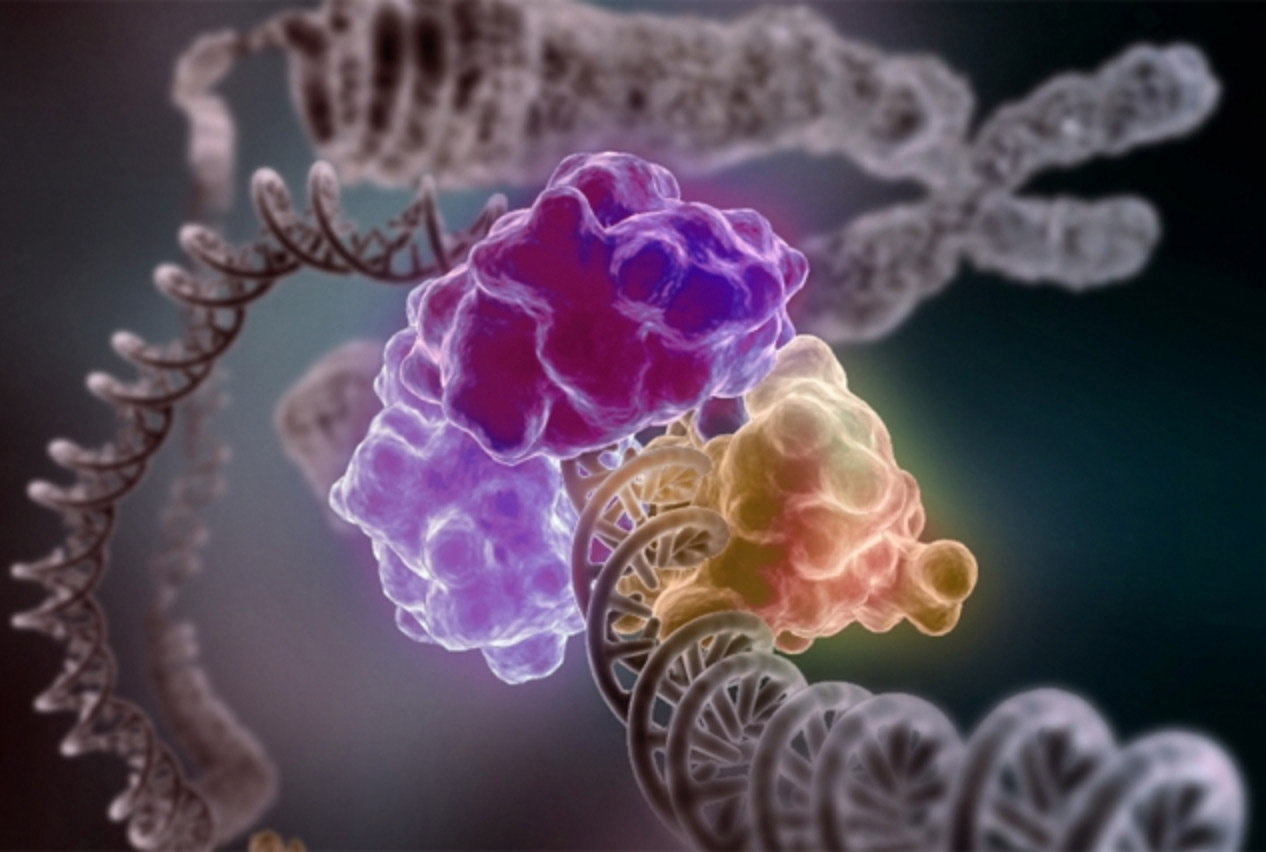
A new study linking RNA processing to DNA repair may open new avenues to cancer therapy.
Bendta Schroeder | Koch Institute
December 3, 2018
Mutations in the BRCA1 and BRCA2 genes pose a serious risk for breast and ovarian cancer because they endanger the genomic stability of a cell by interfering with homologous recombination repair (HR), a key mechanism for accurately repairing harmful double-stranded breaks in DNA. Without the ability to use HR to fix double-stranded breaks, the cell is forced to resort to more error-prone — and thus more cancer-prone — forms of DNA repair.
The BRCA1 and BRCA2 genes are not the only genes whose mutations foster tumorigenesis by causing an inability to repair DNA double strand breaks by HR. Mutations in twenty-two genes are known to disrupt HR, giving rise to tumors with what researchers call “BRCAness” characteristics. All but one of these BRCAness genes are known to be directly involved in the HR pathway.
The one exception, CDK12, is thought to facilitate a set of different processes altogether, involving how RNA transcripts are elongated, spliced and cleaved into their mature forms. While the connection between this RNA-modulating gene to DNA repair remained poorly understood, the identification of CDK12 as a BRCAness gene piqued significant clinical interest.
The researchers who pinpointed this connection, Sara Dubbury and Paul Boutz, both work in the laboratory of Phillip Sharp, Institute Professor, professor of biology, and member of the Koch Institute for Integrative Cancer Research. In a study appearing online in Nature on Nov. 28, they describe how they discovered a previously unknown mechanism by which CDK12 enables the production of full-length RNA transcripts and that this mechanism was especially critical to maintain functional expression of the other BRCAness genes.
When the researchers knocked out expression of CDK12, mouse stem cells showed many signs of accumulating DNA damage that prevented DNA replication from going forward, classic indications of a BRCAness phenotype. To identify what roles CDK12 may play in regulating gene expression, the researchers turned to RNA sequencing to determine which genes had increased or decreased their overall expression.
To their surprise, only genes activated by p53 and early differentiation (side effects of accumulating unrepaired DNA damage and BRCAness in mouse stem cells) accounted for the lion’s share of changes to RNA transcription. However, when the researchers instead focused on the types of RNAs transcribed, they found that many genes produced unusually short transcripts when CDK12 was absent.
Not every stretch of DNA in a gene makes it into the final RNA transcript. The initial RNA from a gene often includes sections, which researchers call “introns,” that are cut out of transcript, the discovery that earned Sharp the 1993 Nobel Prize in Physiology or Medicine and the remaining sections. “Exons,” are spliced together to form a mature transcript (mRNA). Alternately, an intronic polyadenylation (IPA) site may be activated to cleave away the RNA sequence that follows it preventing intron removal and generating a prematurely shortened transcript. These processes allow the same gene to produce alternate forms of messenger RNA (mRNA), and thus be translated into different protein sequences.
Surprisingly CDK12 knockout cells produced significantly more IPA-truncated transcripts genome-wide, while full-length transcripts for the same genes were reduced. These shortened mRNAs can vary greatly in their stability, their ability to be translated into protein, and their protein function. Thus, even while a gene may be actively transcribed, its translation into functional proteins can be radically altered or depleted by IPA activation.
While this observation began to illuminate CDK12’s role in regulating mRNA processing, what remained puzzling was why CDK12 loss affected the HR pathway so disproportionately. In investigating this question, Dubbury and Boutz found that BRCAness genes were overrepresented as a group among those genes that have increased IPA activity upon CDK12 loss.
Additionally, while CDK12 suppresses IPA activity genome-wide, 13 of the other 21 BRCAness genes were found to be particularly vulnerable to CDK12 loss, in part, because they possess multiple high-sensitivity IPA sites, which have a compound effect in decreasing the total amount of full-length transcripts. Moreover, because multiple CDK12-senstive BRCAness genes operate in the same HR pathway, the researchers believe that the disruption to HR repair of double-stranded DNA breaks is amplified.
CDK12 mutations are found recurrently in prostate and ovarian cancer patients, making them an attractive diagnostic and therapeutic target for cancer. However, not enough is known about CDK12 to distinguish between true loss-of-function mutations and so-called “passenger mutations” with no functional consequence.
“The ability to identify patients with true loss-of-function mutations in CDK12 would enable clinicians to label a new cohort of patients with bona fide BRCAness tumors that could benefit from certain highly effective and targeted chemotherapeutics against BRCAness, such as PARP1 inhibitors,” says Dubbury, a former David H. Koch Fellow.
Dubbury and Boutz were able to confirm that IPA sites in key BRCAness genes were also used more frequently upon CDK12 loss in human tumor cells using RNA sequencing data from prostate and ovarian tumor patients with CDK12 mutations and by treating human prostate adenocarcinoma and ovarian carcinoma cells with a CDK12 inhibitor. This result suggests that the CDK12 mechanism observed in mouse cell lines is conserved in humans and that CDK12 mutations in human ovarian and prostate tumors may promote tumorigenesis by increasing IPA activity and thus functionally attenuating HR repair.
“These results not only give us a better understanding how CDK12 contributes to BRCAness, they also may have exciting potential impact in the clinic,” Dubbury says. “Currently available diagnostic techniques could be used to probe the usage of IPA sites found in this study to rapidly screen for patients with true loss-of-function CDK12 mutations, who would respond to BRCAness-targeted treatments.”
Paul Boutz, a research scientist in the Sharp Lab, is co-first author of the study, and has plans to follow-up many of these implications for ovarian and prostate cancer his lab at the University of Rochester School of Medicine and Dentistry.
“CDK12 provides a remarkable example of how factors that control the processing of RNA molecules can function as master regulators of gene networks, and thereby profoundly affect the physiology of both normal and cancerous cells,” he says.
Phil Sharp, the senior author on the work, says “Sara’s and Paul’s surprising discovery that CDK12 suppresses intronic polyadenylation has implications for fundamental new insights into gene structure as well as for control of cancer.”
